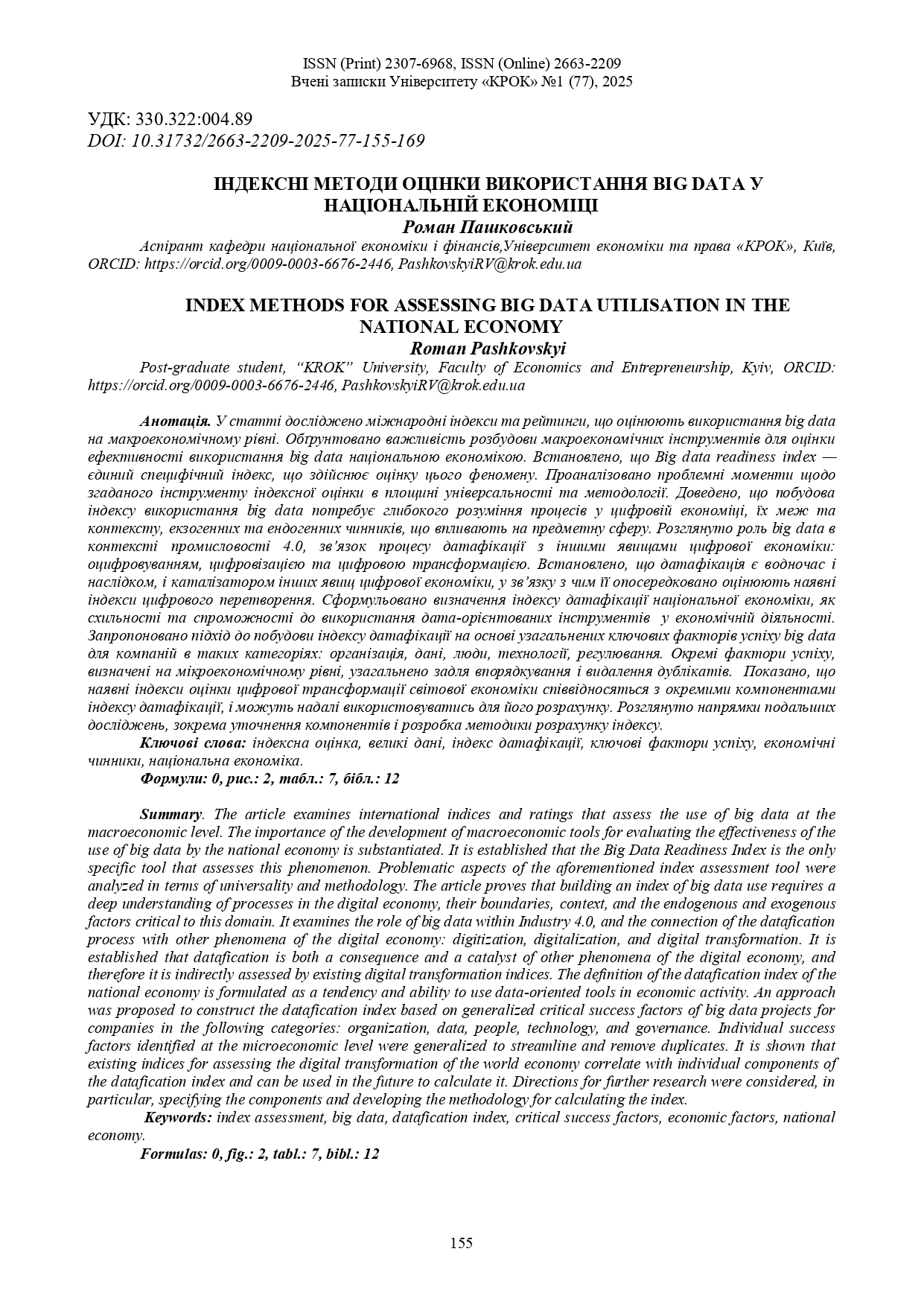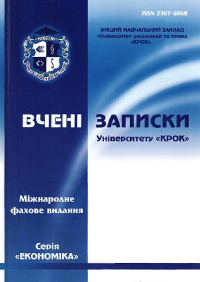INDEX METHODS FOR ASSESSING BIG DATA UTILISATION BY THE NATIONAL ECONOMY
DOI:
https://doi.org/10.31732/2663-2209-2025-77-155-169Keywords:
index assessment, big data, datafication index, critical success factorsAbstract
The article examines international indices and ratings that assess the use of big data at the macroeconomic level. It is established that the Big Data Readiness Index is the only specific tool that assesses this phenomenon. Problematic aspects of the aforementioned index assessment tool were analyzed in terms of universality and methodology. The article proves that building an index of big data use requires a deep understanding of processes in the digital economy, their boundaries, and context. It examines the role of big data within Industry 4.0, and the connection of the datafication process with other phenomena of the digital economy: digitization, digitalization, and digital transformation. It is established that datafication is both a consequence and a catalyst of other phenomena of the digital economy, and therefore it is indirectly assessed by existing digital transformation indices. The definition of the datafication index of the national economy is formulated as a tendency and ability to use data-oriented tools in economic activity. An approach was proposed to construct the datafication index based on generalized critical success factors of big data projects for companies in the following categories: organization, data, people, technology, and governance. Individual success factors identified at the macroeconomic level were generalized to streamline and remove duplicates. It is shown that existing indices for assessing the digital transformation of the world economy correlate with individual components of the datafication index and can be used in the future to calculate it. Directions for further research were considered, in particular, specifying the components and developing the methodology for calculating the index.
Downloads
References
Anderson, S. P., & de Palma, A. (2022). GDPR and the lost generation of innovative apps (NBER Working Paper No. 30028). National Bureau of Economic Research. https://doi.org/10.3386/w30028
Al-Sai, Z. A., Abdullah, R., & Husin, M. H. (2020). Critical success factors for big data: A systematic literature review. IEEE Access, 8, 118940-118956. https://doi.org/10.1109/ACCESS.2020.3005461
Андрієнко, В. Ю. (2004). Статистичні індекси в економічних дослідженнях. – К. : 2004 р., с. 13–17. https://www.myslenedrevo.com.ua/uk/Sci/Economics/StatIndices/IndexMethod/LinksOtherMethods.html
Василенко, В. М. (2017). Концепція Big Data в Україні: Перспективи застосування в державних органах. Серія: Державне управління, 4. http://pa.stateandregions.zp.ua/archive/4_2017/19.pdf
Digitization, digitalization, digital and transformation: The differences. (n.d.). Retrieved from https://www.i-scoop.eu/digital-transformation/digitization-digitalization-digital-transformation-disruption/
Gartner’s IT glossary. (n.d.). Retrieved from https://www.gartner.com/en/information-technology/glossary
Joubert, A., Murawski, M., & Bick, M. (2019). Big Data readiness index – Africa in the age of analytics. In I. O. Pappas, P. Mikalef, Y. K. Dwivedi, L. Jaccheri, J. Krogstie, & M. Mäntymäki (Eds.), Digital transformation for a sustainable society in the 21st century (pp. 91–101). Lecture Notes in Computer Science, vol 11701. Springer, Cham. https://doi.org/10.1007/978-3-030-29374-1_9
Malecki, E., & Moriset, B. (2007). The digital economy: Business organization, production processes, and regional developments (1st ed.). Routledge. https://doi.org/10.4324/9780203933633
Mesenbourg, T. L. (2001). Measuring the digital economy (US Bureau of the Census). Retrieved from https://www.census.gov/content/dam/Census/library/workingpapers/2001/econ/umdigital.pdf
Panda, S. (2022). Digitization of knowledge management methods: An essential approach. Zenodo. https://doi.org/10.5281/zenodo.7760149
Погорєлова, Т. В., & Тарасова, К. І. (2021). Індексний метод у сучасних дослідженнях грошового обігу України. Вісник соціально-економічних досліджень: зб. наук. праць, 1(76), 100-112.
Tang, L., Lu, B., & Tian, T. (2021). Spatial correlation network and regional differences for the development of digital economy in China. Entropy, 23(12), 1575. https://doi.org/10.3390/e23121575
Toolkit for measuring the digital economy: G20 report. (2018). Retrieved from https://www.itu.int/en/ITU-D/Statistics/Documents/g20-detf-toolkit_FINAL.pdf

Downloads
Published
How to Cite
Issue
Section
License

This work is licensed under a Creative Commons Attribution-NonCommercial 4.0 International License.

